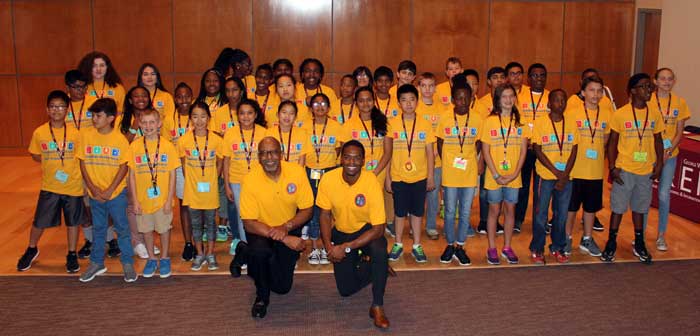Astronaut Bernard Harris gives advice to future STEM leaders
In 1969, 13-year-old Bernard Harris Jr. witnessed the pinnacle achievement of the American space program as astronauts Neil Armstrong and Edwin “Buzz” Aldrin became the first people to walk on the moon.
When the astronauts returned, the American people celebrated their extraordinary achievements with ticker-tape parades. Harris was determined to follow their footsteps into space.
“They were called American heroes,” he said. “I wanted to be an American hero.”
During the ExxonMobil Bernard Harris Summer Science Camp July 11 in the University of Arkansas at Little Rock College of Engineering and Information Technology, Harris told a group of 36 participants the story of how he became the first African American to walk in space.
Sponsored by the ExxonMobil Foundation and Harris, the camp offers middle school students in underserved and underrepresented populations a free, two-week learning experience in science, technology, engineering, and math (STEM).
Harris recognizes that middle school is a critical time when most students might give up on pursuing STEM-related majors and careers. He hopes his story will inspire campers to pursue math and science educational opportunities.
“When you finish college, we want to make sure you have a job to take care of yourself and your family, so you can give back to your community,” he said.
After watching the moon landing, Harris began his lifelong dream to travel to space by learning everything he could about astronauts and what it took to become one. However, it didn’t take him long to notice that there were no African American astronauts for him to admire.
“Just after the end of the Civil Rights Movement, there wasn’t much expectation for somebody who looked like me to go into space,” he said. “There wasn’t much expectation for somebody who was black, or Hispanic, or Asian, or a woman to be an astronaut.”
He told camp participants they should not be ashamed for being future leaders in STEM fields.
“I got teased about being smart,” Harris recalled of his school years. “Sometimes, it’s not cool to be smart. In this camp, it’s cool to be smart. You are surrounded by the future leaders of America.”
After earning a Doctorate of Medicine from Texas Tech University, Harris completed a residency in internal medicine at the Mayo Clinic and a National Council fellowship in endocrinology at the NASA Ames Research Center. In addition, he trained as a flight surgeon.
In 1990, Harris was one of only about 20 people out of more than 6,000 applicants selected into the Astronaut Corp. He was a mission specialist on the Space Shuttle Columbia in 1993. As payload commander on Space Shuttle Discovery in 1995, he served on the first flight of the joint Russian-American Space Program, becoming the first African American to walk in space.
Harris worked at NASA for a decade, conducting research in musculoskeletal physiology and disuse osteoporosis. He conducted clinical investigations of space adaptation and developed in-flight medical devices to safely extend astronauts’ time in space.
When asked what he missed the most about being in space, Harris said floating around the space shuttle in zero gravity, since it allowed him to “fulfill another childhood dream of being Superman.”
